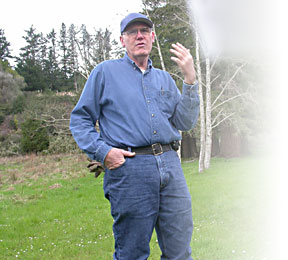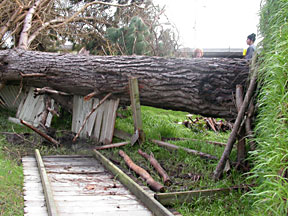 
COVER STORY | IN
THE NEWS | OPINION
| DIRT
TALK OF THE TABLE | THE HUM | CALENDAR
February 2, 2006


PERILOUS: The bride and groom walked
the gangplank. They pawed nervously at their faces on occasion,
then turned to smile bravely at the crowd. The rain fell. Out
there, in that crowd, the people had umbrellas, sure footing,
and -- at least to the public eye -- control of the situation.
Maybe they'd already taken the plunge, sat in the honeymoon hot
tub afterward, then retreated back to the observation deck to
shiver in smug sympathy. Maybe they didn't intend, ever, to jump
in that water, and just came to heckle or marvel at the fools
inching down the gangplank to the edge.
The rain fell. The people under the umbrellas leaned
forward, eyes gleaming. Many splashes preceded the bride and
groom, more self-sacrificial plungers testing the waters. Some
Fish and Game people, large fishes wedged onto their heads, walked
just in front of the bride and groom. A clown -- much like the
clown at the rodeo, waiting in the wings to distract the angry
bull -- waited behind the bride and groom on the gangplank. He'd
jump in after them, try to distract the sharks (or sleek territorial
sea lions, although those bay dwellers seemed to be giving the
waterfront a wide berth this Saturday morn).
And then, without even an "I do," someone
tossed the bride over his shoulder and heaved her into the bay.
The groom followed -- or did they jump together? It was hard
to tell, back in the crowd, where kids played with umbrellas,
dogs sat patiently and neighbors gossiped. The rain and the clouds
rolled back into hesitant clumps on the near horizon and the
sun peeked out.
They say it's good to get married in the rain,
even better if the sun makes an appearance soon thereafter. But
that's neither here nor there: This was the Perilous Plunge --
not a real wedding, silly -- a fundraiser for the Campfire USA
and the Discovery Museum, and 150-plus characters cavorted around
in the cold and wet before launching their charitable selves
into the bay. And let's not forget the man paddling around in
his Speedo for hours in the water while the people plunged, his
skin turning red, ready to fish people out if they failed to
surface. What was he, the preacher?
REGGAE EXPANSION: At a public hearing this
Thursday, Feb. 2, before the Humboldt County Planning Commission,
People Productions will explain why it wants to expand its Reggae
on the River celebration in August onto 120 acres south of the
present site, increase ticket sales from 8,500 to 12,000, and
add another day of camping to the already three-day event. If
the expansion is allowed, ROR could jump from 10,500 people skankin'
on the riverbank to 14,400 (figuring in staff, performers and
guests along with the ticket buyers). ROR organizers also want
to have the conditional use permit under which all of these rules
are detailed to be extended from 2007 to 2015.
But -- as reports from contentious meetings down
in SoHum reveal -- some other people might rise before the commission
to explain why they're a little concerned about the proposed
expansion. According to a report in the Jan. 24 Redwood Times
written by Mary Anderson, some residents of Piercy -- just over
the border in Mendocino County, are worried that ROR's growth
is both unchecked as well as congestion-causing. Anderson herself
opined: "In the end, making Reggae work for everyone is
an unachievable goal."
Carol Bruno, of People Productions, responded to
that claim this Monday: "We're really working hard to make
it work for everyone." She added: "We want to expand
because we need to cover the [increased expenses from] inflation."
The planning commission meets at 6 p.m. in the Board of Supervisors'
chambers at the courthouse in Eureka and again on Feb. 16, same
place same time, to consider the matter.
WATER SAY-SO: The California Supreme Court
on Monday decided that the state and regional water boards do
indeed have the authority to tell logging companies to monitor
water quality in streams and rivers potentially affected by their
timber harvesting.
The unanimous ruling upset the Pacific Lumber Company's
last-ditch effort to dismiss the water boards as unessential,
extraneous flies in the state agency ointment. Palco had sued
the State Water Resources Control Board after the board ordered
the company to monitor water quality, and remediate problems,
in the South Fork Elk River, where erosion, landslides and heavy
sediment loads in the watershed have been associated with past
logging. Palco declared that the only authority it had to answer
to was that of the California Department of Forestry, which regulates
timber cutting under the Forest Practice Act. The Supreme Court
unanimously dismissed that argument as "flawed" because
part of the Forest Practice Act says that it doesn't limit another
state agency from exercising its authority.
The Supreme Court ruling, the water board notes
in a news release, extends beyond Humboldt County, and along
with other recent victories in the water authority realm reaffirms
the state's role in protecting California water.
EUREKA SKULLDUGGERY: A person walking through
the softball fields at Cooper Gulch recreational area in Eureka
discovered part of a skull at 4:30 p.m. on Monday. EPD, Eureka
Volunteer Patrol, a police dog and the Humboldt County Sheriff's
Office divided the fields into three quadrants and combed the
area searching for clues. Other bones were found, including some
vertebrae, according to police. The Humboldt County Coroner's
Office took possession of the remains Monday and a local anthropologist
has also examined the bones. Coroner Frank Jager said Tuesday
that from his preliminary examination, the skull appears to be
that of a young Caucasian female, 25 to 35 years old or younger.
Police recovered 75 percent of the skull, which, according to
Jager, was "broken up pretty good." Jager also said
that the bones appear to have been outdoors or buried in excess
of one year, though they were not buried at Cooper's Gulch but
placed there "by someone or something" more recently.
An investigation is continuing.
SHANTY STABBING: A bar brawl nearly turned
fatal after a bar patron was stabbed repeatedly in the torso
and arms last Wednesday evening in Eureka. Matthew Eric Fordham,
25, of Eureka, was assaulted outside of the Shanty, an Old Town
bar, following a verbal altercation with three men and one woman
that took place in the back smoking area. Two people were sought
by Eureka Police for questioning, and since the stabbing one
person allegedly involved in the altercation, Katie Oswald, has
been contacted by EPD. Also sought for questioning is a man who
goes by the name of Ritchie Cunningham. Oswald, Cunningham and
the other assailants were reportedly not regulars at the Shanty
but were somehow known to the victim, though police said they
were "not friends." Fordham was taken to the St. Joseph's
hospital with major injuries. Anyone with information should
call Detective Neil Hubbard at 441-4300.
STRIKE TWO: On Monday, the Journal
received letters from Marie Maloney and Naomi Steinberg, two
people mentioned in the Trinidad Police Department's reports
on the Richard Salzman false-name investigation (see "The
final Salzman tally?" Jan. 26). TPD Chief Ken Thrailkill
had written in his report that Salzman appeared to use Maloney's
and Steinberg's names as two aliases in his letter-to-the-editor
campaigns; Maloney and Steinberg wrote the Journal to
say that it wasn't so.
The Journal called back to each of the women,
and the ensuing conversations re-proved something we already
knew: Journal readers are the smartest people around,
and among the most gracious. As the Journal pointed out
last week, the only evidence that the TPD appeared to have was
that Salzman had letters-to-the-editor written under their names
stored on his computer. Maloney wasn't sure if that was even
the case -- she said that conversations with Thrailkill after
the fact seemed to indicate that what was stored on the computer
were e-mails to county supervisors that she may have cc:'d Salzman
on.
Both Maloney and Steinberg wondered why the Journal
would have printed something on such seemingly shaky evidence,
and we had long, interesting and civil conversations -- agreeing
to disagree, at times. The nut of the Journal's argument
was that we were reporting on the contents of the police report,
which did contain incontrovertible evidence that the Salzman
letter campaign was more widespread and of longer vintage than
was previously known, and that one of his computers went missing
shortly after the investigation began. The evidence was much
shakier in some instances than others, and we did our best to
make clear when it was.
Steinberg did make a point that we take to heart,
though -- that our use of the phrase "did not return a phone
call seeking comment" in reference to our attempt to reach
her for last week's story was perhaps off the mark. As it happened,
she was out of town when we placed the call and ill after she
returned. Though we couldn't have known that at the time, we
do know Steinberg, and we should have known that she'd be about
the last person you'd expect to duck a call, no matter how tough
the questions. In this case, another of journalism's stock phrases
-- "could not be reached for comment" -- would have
been more appropriate.
TOP
 Who moved my tree? Who moved my tree?
Remember: If a tree falls on your house, God
did it
story and photos by HELEN SANDERSON
Raymond Fagot (left) trudged toward the
fallen Monterey pine that stretched across the edge of his one-
and-a-half-acre property in Arcata Friday afternoon. His size
13 black rubber boots squished along the sodden ground as he
neared the tree, with its grassy, uprooted base protruding skyward
from where it stood in his neighbor's yard for more than 40 years.
The 80-foot pine was on its side, a small wooden fence crushed
beneath it.
As he sloshed through the wet grass, the retired
59-year-old apologized for the soggy state of the ground, explaining
that the Sunny Brae hillside near his place, where he's lived
since 1967, slopes in such a way that a pool forms in this part
of the property. A while back, he considered digging a ditch
to divert some of the runoff into a nearby creek but, he said,
you can't do things like that nowadays.
Fagot seems like an industrious type, a do-it-yourself
sort with jalopy trucks awaiting repair in the driveway. He's
also the kind of guy who does things by the book. It could be
that his follow-the-rules attitude is a testament to his former
career as a police sergeant for Humboldt State University where,
for a time, he trained staff in emergency preparedness and equipment
maintenance.
 So
when that pine tree crashed into his yard during the New Year's
storm, it wasn't long before he was on the phone with his insurance
agent to find out what should be done. Since Fagot reads all
of his (boring) insurance policy mail and even has a Nolo Press
book on "neighborhood law" that he consults from time
to time, he already knew what his agent told him -- that his
neighbor was not liable for the downed tree. From an insurer's
standpoint, the storm and resulting damage was "an act of
God," meaning it was a force of nature; it was no one's
fault, and therefore insurers aren't financially liable for damage
to other people's property. So
when that pine tree crashed into his yard during the New Year's
storm, it wasn't long before he was on the phone with his insurance
agent to find out what should be done. Since Fagot reads all
of his (boring) insurance policy mail and even has a Nolo Press
book on "neighborhood law" that he consults from time
to time, he already knew what his agent told him -- that his
neighbor was not liable for the downed tree. From an insurer's
standpoint, the storm and resulting damage was "an act of
God," meaning it was a force of nature; it was no one's
fault, and therefore insurers aren't financially liable for damage
to other people's property.
"That's the way the law is. Some people assume
there should be responsibility on the person who owns the tree,"
Fagot said. "It's just the way the wind blows."
Instead, the burden of removing the arboreal mess
is on Fagot, whose yard is far more compromised than his neighbor's.
But it could have been worse -- the tree missed a nearby rental
he owns. He estimates it might cost around $1,500 to get the
thing chopped up and hauled off by a professional. He decided
not to file an insurance claim, because he heard a few years
back that if you are a "chronic filer" with your insurance
company, you might be denied a policy with other insurers in
the future.
But it's not the money that's bothering him, anyway.
He's not even mad at his neighbor -- nor at God, for that matter.
Fagot just wishes more people realized that when a natural disaster
occurs it is too late to remove any unstable trees or structures
that might crash into your yard and subsequently drain your wallet.
He wants to use his own entanglement with the Monterey pine,
which is still lying in his yard a month later, as an example
for other homeowners who might find themselves in a worse situation.
Fagot's State Farm agent, John "Grondo"
Grondalski, said that since the New Year's storm he's had to
deliver disappointing news -- that their neighbor doesn't have
to pay for any damage -- to clients with a similar state of affairs
as Fagot.
"The neighbor didn't cause the tree to fall,
nature did," Grondalski explained during a call from his
Arcata office. "So the insurance industry, a long time ago,
just decided, hey, when it's an act of God, whatever falls in
my yard my insurance covers and whatever's in your yard your
insurance covers. So if [a tree] smashes your garage and then
continues across the driveway and smashes my car, your insurance
covers your garage and my insurance covers my car."
Something both Fagot and Grondalski pointed out,
however, is that you, the homeowner, can protect yourself from
your neighbor's tumbling trees by checking around your property
for those leaning or decaying trees and structures that might
blow over in a strong wind.
"Look at the ground around [the tree],"
Grondo suggested, "and if it looks like it might be pulling
up a little bit the best thing to do is to write a letter --
and get it certified -- that says: I'm concerned about that redwood
tree and please take care of it before it causes any damage."
At that point, it would be up to the property owner
to take down the tree. And if it were to someday fall, the neighbor
and their insurance company would be responsible for any damage
to your place.
Another thing to watch out for, Grondalski said,
are "widow-makers," loose limbs in redwood trees that
might plummet to the ground and thump an unlucky person below,
thus making their significant-other a widow. It's a logging term.
Fagot never considered that that particular tree
would go down. It appeared healthy (though he thought it was
nevertheless unattractive) so the certified letter rigmarole
wouldn't have done him any good.
His neighbor, Deva Wheeler, said that she too,
never imagined the tree would fall, and that even after it crashed
into Fagot's backyard, she wasn't aware of the rules that applied
to the "act of God" insurance situation.
"In fact," Wheeler said, "we never
considered it would be our neighbor's responsibility at all;
we thought it was ours. It was [Fagot] who actually pointed it
out. He seems committed to doing things by the book and he said,
`No, no, I'll deal with what's on my side of the fence.' So we
said, `OK.'"
Her insurance will pay for the wrecked fence, she
said, and she's lined up someone to cut the tree on her side,
but he's been backed up with other jobs since the storm. Meanwhile,
there are no more large trees on Wheeler's property -- just some
small hardwoods, she said.
"If there were large trees I probably would
be worried about it and I might just want to take them down,"
she said.
As for Fagot, he's actually happy that the old
Monterey Pine went down: Now he has a view of Arcata Bay from
his kitchen window. Besides, having professionals cut a standing
tree down would have cost more money than he's paying now --
at most $8,000, he estimates. So, in this case, God did him a
favor. But again, he thinks the whole mishap serves as an example,
to take care of suspect trees before they crash into your yard
or make a widow out of someone.
TOP
COVER STORY | IN
THE NEWS | OPINION
| DIRT
TALK OF THE TABLE | THE HUM | CALENDAR
Comments? Write
a letter!

© Copyright 2006, North Coast Journal,
Inc.
|